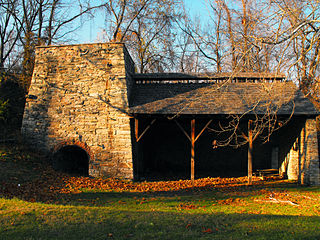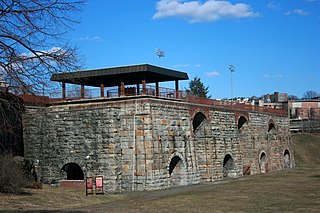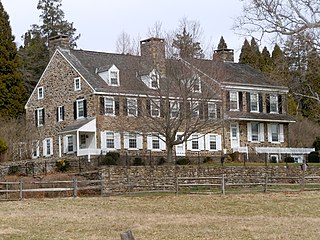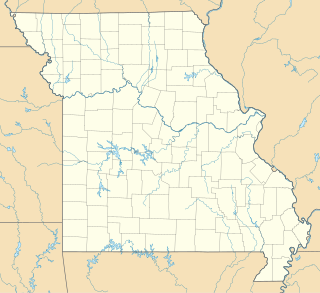
Oxford Furnace is a historic blast furnace on Washington Avenue, near the intersection with Belvidere Avenue, in Oxford, Oxford Township, Warren County, New Jersey. The furnace was built starting in 1741 and produced its first pig iron in 1743. The first practical use in the United States of hot blast furnace technology took place here in 1834. The furnace was added to the National Register of Historic Places on July 6, 1977 for its significance in industry during the 19th century. It was later added as a contributing property to the Oxford Industrial Historic District on August 27, 1992.

Catoctin Furnace is a historic iron forge located on Route 15 between Frederick and Thurmont in Catoctin Furnace, Maryland. The smelting blast furnace is shown. No forge is at the site now. Forges were present when the ironworks was operational.

The Scranton Iron Furnaces is a historic site that preserves the heritage of iron making in the U.S. State of Pennsylvania and is located in Scranton, near the Steamtown National Historic Site. It protects the remains of four stone blast furnaces which were built between 1848 and 1857. Iron production on the site was started by Scranton, Grant & Company in 1840. Later, the furnaces were operated by the Lackawanna Iron & Coal Company. In 1847, iron rails for the Erie Railroad were made at the site. In 1865, Scranton, Grant & Company had the largest iron production capacity in the United States. In 1875, steel production started at the site. In 1880, the furnaces produced 125,000 tons of pig iron, one of the main uses of which was in the making of t-rails. The plant was closed in 1902, when production was shifted to Lackawanna, New York.

Longdale Furnace is an unincorporated community located east of Clifton Forge in Alleghany County, Virginia, United States.

Antietam Iron Furnace Site and Antietam Village is a national historic district at Antietam, Washington County, Maryland, United States. The district consists of the remains of a mid-18th to late-19th century iron furnace site, and the nearby related village. Remnants of the ironworks include a dam and race, a possible wheel pit or building foundation, the possible location of a furnace stack, a four-arch stone bridge built by John Weaver in 1832. Also at the site are the dozen or so brick, stone, and wood houses comprising Antietam Village. Typical of the houses is the Mentzer house, a four-bay, two-story, stone structure constructed of roughly coursed fieldstone and painted white.
This is a list of the National Register of Historic Places listings in Stewart County, Tennessee.

Warwick Furnace Farms is a historic district in northern Chester County, Pennsylvania that includes the ruins of an early iron furnace, the ironmaster's house and workers' houses, as well as a historic farm house and barns now used in the operation of a working farm. The furnace was a center of colonial iron making and is associated with the introduction of the Franklin Stove, and the retreat of George Washington's army following its defeat at the Battle of Brandywine. The furnace operated through the 1860s and supplied the iron used in the iron-clad ship the USS Monitor during the Civil War. The 786 acre historic district was listed by the National Register of Historic Places in 1976.

Monroe Furnace is a national historic district and historic iron furnace located at Barree Township in Huntingdon County, Pennsylvania. It consists of 1 contributing site and 1 contributing structure. They are the remains of the furnace stack, its immediate surroundings, and the visible foundation remains of 14 workers' houses. The furnace stack measures 30 feet square at the base and stands 20 feet tall. The furnace was established in 1846-1847 by General James Irvin. It was in operation until 1863. It is included in the Pennsylvania State University Experimental Forest.

Huntingdon Furnace is a national historic district and historic iron furnace and associated buildings located at Franklin Township in Huntingdon County, Pennsylvania. It consists of seven contributing buildings and one contributing structure. They are the iron furnace, office building, the ironmaster's mansion, log worker's house, a residence, the farm manager's residence, the grist mill and the miller's house. The iron furnace was moved to this site in 1805, from its original site one mile upstream. It measures 30 feet square by 30 feet high. The ironmaster's mansion was built in 1851, and is a 2 1/2-story, "L"-shaped frame dwelling. The grist mill dates to 1808, and is a 3 1/2-story, rubble stone building measuring 50 feet by 45 feet. The furnace was in operation from 1796, until it ceased operations in the 1880s.

Barree Forge and Furnace, now known as Greene Hills Methodist Camp, is a national historic district located at Porter Township in Huntingdon County, Pennsylvania. It consists of two contributing buildings, one contributing site, and one contributing structure associated with a former ironworks. They are the ironmaster's mansion, furnace stack, a barn, and the site of the Barree iron forge built about 1797. The ironmaster's mansion was built in the 1830s, and is a 2 1/2-story brick house painted white. The furnace stack dates to 1864, and is a 30-foot square, coursed limestone structure. It measures between 6 and 15 feet tall. The ironworks closed in the 1880s. The property was acquired in 1963, by the United Methodist Church for use as a church camp.

Paradise Furnace, also known as Mary Anne Furnace, is a national historic district located in Trough Creek State Park at Todd Township in Huntingdon County, Pennsylvania. It consists of two contributing buildings and one contributing structure associated with a former iron furnace. They are the ironmaster's mansion, furnace stack, and a log workers' house. The ironmaster's mansion was built in the 1830s, and is a 2 1/2-story stone house in the Georgian plan. The furnace stack dates to the 1830s, and is a 28-foot square, coursed rubble stone structure. It measures between 15 and 20 feet tall. The ironworks operated from the late-18th century into the 1860s, when economic conditions caused it to be fired. The two-story log house dates to the late-18th century. It was converted for use as the park visitor's center / museum in 1982.

Carrick Furnace is a historic iron furnace located at Metal Township in Franklin County, Pennsylvania. The property includes the limestone furnace stack, a Peter L. Weimer blowing engine (1879), boilers for the steam engine, and the charging ramp, engine house, and cast house foundations. The furnace was built about 1828, and measures 30 feet square at the base and 30 feet high. Furnace operations were suspended in 1837, the property sold in 1843, then leased in 1850 to "Witherow and Walker." The furnace was converted in 1879 to hot blast with the installation of the steam-powered blowing engine. The furnace went out of blast in 1884, and was donated to the Franklin County Historical Society-Kittochtinney in 1935.

Franklin Furnace Historic District is a national historic district located in St. Thomas Township, Franklin County, Pennsylvania. The district includes five contributing buildings, one contributing structure, and one contributing site associated with a 19th-century iron furnace plantation. The buildings are the manager's house / office and four workers' houses. The structure is the furnace stack (1828). It measures 30 feet square at the base and approximately 30 feet tall. The contributing site is the ruins of a barn. The furnace ceased full operation in 1882.

Callie Furnace is a historic iron furnace located near Glen Wilton, Botetourt County, Virginia. It was built as a hot-blast charcoal furnace around 1873-1874, and subsequently enlarged and converted into a coke furnace. In 1883, the stack was raised an additional five feet, and a tuyere was added. Callie Furnace went out of blast in 1884.

Scotia Iron Furnace Stack is a historic iron furnace stack located near Leasburg, Crawford County, Missouri. It was built about 1870 by the Scotia Iron Works, and is 35 feet wide at the base, and approximately 40 feet high. It is constructed of native limestone blocks. The furnace remained in operation until 1880.

Ozark Iron Furnace Stack, also known as the Ozark Iron Works, is a historic iron furnace located near Newburg, Phelps County, Missouri. It was built in 1873, and is a pyramidal shaped furnace stack constructed of hard, compact, fine-drained sandstone blocks on a solid rock foundation. It measures approximately 40 feet high. The furnace operate until 1884.

George Cresswell Furnace, also known as the George Cresswell Furnace Stack is a historic lead furnace located near Potosi, Washington County, Missouri. It was built about 1840, and is an open hearth furnace measuring about 100 feet square at its base and constructed of massive limestone blocks interlaced with mortar. The stack rises to a height of approximately 25 feet.

The Bourbon Iron Works, near Owingsville in Bath County, Kentucky, date from 1791. The works was listed on the National Register of Historic Places in 1976.






















